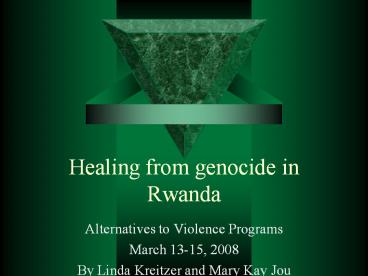Healing from genocide in Rwanda - PowerPoint PPT Presentation
1 / 23
Title:
Healing from genocide in Rwanda
Description:
Alternatives to Violence Programs (AVP) Mary Kay's work in Rwanda and the Congo. ... 2006 Multi-party elections were held and Kabila was sworn in as president. ... – PowerPoint PPT presentation
Number of Views:157
Avg rating:3.0/5.0
Title: Healing from genocide in Rwanda
1
Healing from genocide in Rwanda
- Alternatives to Violence Programs
- March 13-15, 2008
- By Linda Kreitzer and Mary Kay Jou
2
Map of Rwanda
3
Agenda of workshop
- Historical background of both Rwanda and the
Congo and current situation. - Alternatives to Violence Programs (AVP)
- Mary Kays work in Rwanda and the Congo.
4
History of Rwanda
- Pre-colonial period Tutsi cattle breeders
arrived in Central Africa and established a
monarchy headed by a king and a feudal hierarchy
of Tutsi nobles and gentry. Over the years race
and class were less distinct and there was
peaceful times of living together. - End of 19th century Nyiginya dynasty
- Hutus tended to be farmers, Tutsis were
stockbreeders and Twa were hunters or potters.
5
Colonialism
- First European, a German, came to what is now
Rwanda followed by the white fathers or
missionaries. - Belgium rule 1915-1962.
- Hamitic hypothesis
- 1959 revolt
- 1960-61 Hutu election victory
- 1961 1967 Tutsi massacres
6
After Independence
- First republic 1962-1973 Kept up with racial
profiling. This time the Hutus were seen as the
rightful inhabitants and the Tutsis were
foreigners. - 1972-1973 Ethnic violence erupted with more
massacres. - 1973-1994 Habyarimana government
- 1994 Second genocide
7
History of Rwanda cont.
- The 1994 genocide in Rwanda was unprecedented and
over 800,000 men, women and children were
murdered. Within 4 months, 1.75 million people
had fled. - Work has been going on in Rwanda after the
genocide to promote sustainability with economic
and social development.
8
(No Transcript)
9
History of Congo
- Pre-colonial
- Colonizaton (1908-1960)
- Republic of Congo (1960-65)
- Zaire (1965-1996)
- DR of Congo (1997)
10
DR of Congos relationship to Rwanda
- 1996 Rwandan war and genocide had spilled over
to Zaire. - Use of refugee camps for Hutu military.
- Hutus and Zairian military join to fight
Congolese ethnic Tutsis. - Tutsi militia was supported by Rwanda and Uganda
to oust Mobutu. Kabila named himself president
when Mobutu left. - 1997 renamed the DR of Congo
11
DR of Congos relationship to Rwanda
- Several peace deals were brokered between Rwanda
and Uganda but more fighting continued. - By June 2003 all foreign troops except Rwanda
pulled out of the Congo - 2006 Multi-party elections were held and Kabila
was sworn in as president. - There are still Rwandan refugees in the Congo and
a ceasefire was again obtained between Rwanda and
the Congo in 2007. Rwanda continues to chase down
Hutu on the Congolese side and tensions remain
high between the countries.
12
Rwanda today
- Visit to Rwanda
- Economic situation
- Political situation
- Psychological healing from the genocide.
- a. International Criminal Tribunal for
- Rwanda
- b. Gacaca system
13
Rwanda Today
- c. Memorialization
- d. Solidarity camps
14
Genocide healing and reconcilation
- True healing of a country includes addressing the
social, economic, political and emotional needs
of a country. Development activities can help
reduce mental health problems due to the war. On
the other hand, trauma healing can help to
strengthen people to contribute to development. - NGOs
15
(No Transcript)
16
Projects and interventions
- International Rescue Committee
- UNICEF
17
Projects and interventions
- There has been research and programs set up to
deal with trauma from the genocide. - One particular work has been by Ervin Staub,
Laurie Pearlman and Vachel Miller. - Another is by Annemiek Richters, Cora Dekker and
Klaas de Jonge.
18
Staub, Pearlman and Miller
- Work looks at the relationship between
reconciliation and forgiveness. - Reconciliation
- Forgiveness
19
Staub, Pearlman and Miller
- Developing an intervention that could be used by
groups after researchers left. - Two-week seminar with Rwandans from local and
international NGO. - Seminars for national leaders.
- Evaluation of the Gacaca system.
- Seminars with journalists
- Radio programs
20
Richters, Dekker and de Jonge
- Socio-therapy
- Focuses less on terrible memories of the past and
focuses primarily on the here and now situation. - Main goal is increasing safety and trust within a
group
21
(No Transcript)
22
References
- A. Richters, C. Dekker K. deJonge (2005).
Reconciliation in the aftermath of violent
conflict in Rwanda. Intervention, 3, 3, 203-221. - E. Staub, L.A. Pearlman V. Miller (2003).
Healing the roots of genocide in Rwanda, Peace
Review, 15, 3, 287-294.
23
References
- E. Staub, L.A. Pearlman, A. Gubin A.
Hagengimana (2005). Healing, reconciliation,
forgiving and the prevention of violence after
genocide or mass killing An intervention and its
experimental evaluation in Rwanda. Journal of
social and clinical psychology, 24, 3, 297-334. - A. Dyregrov, L. Gupta, R. Gjestad E. Mukanoheli
(2000). Trauma exposure and psychological
reactions to genocide among Rwandan children.
Journal of traumatic stress, 13, 1, 3-21.































